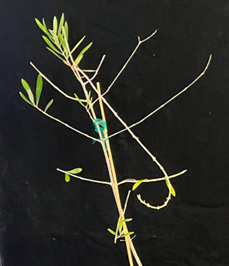| Elizabeth Rogers |

|
Contact information
Dr. Elizabeth Rogers
elizabeth.rogers@usda.gov
Foreign Disease/Weed Science Research
1301 Ditto Avenue, Fort Detrick, MD 21702
Phone: (301) 619-7307
Fax: (301) 619-2880

Dr. Rogers is a research microbiologist and lead scientist of the insect vectored pathogens project for the USDA-ARS Foreign Disease/Weed Science Research Unit (FDWSRU). She started with USDA-ARS in 2008 in the Crop Diseases, Pests, and Genetics (CDPG) located at the San Joaquin Valley Agricultural Sciences Center in Parlier, CA. In 2015, she moved to FDWSRU where she studies emerging and invasive bacterial and viral pathogen threats to U.S. agriculture.
Research Emphasis
The Rogers lab currently has research projects on Rathayibacter toxicus, which is the causative agent of Annual Ryegrass Toxicity in Australia, Xylophilus ampelinus, which is responsible for bacterial canker of grapevine in South Africa and parts of Europe, olive and citrus infecting strains of Xylella fastidiosa, and Plum Pox Virus.

Plum leaf showing typical symptoms of plum pox virus infection.

Rathayibacter toxicus growing on a petri plate.

Olive branches that have dropped their leaves are a typical symptom of olive quick decline syndrome caused by Xylella fastidiosa.
Projects
Publications
- Use the drop down box below to view publications at USDA-ARS:
Education
Ph.D. in Genetics, Harvard University
B.A. in Chemistry and Molecular Biology, Haverford College
Research Experience
- Lead Scientist and Research Microbiologist, USDA-ARS, Foreign Disease/Weed Science Unit, Frederick, MD, 2017-present.
- Research Microbiologist, USDA-ARS, Foreign Disease/Weed Science Unit, Frederick, MD, 2015-2017.
- Research Molecular Biologist, USDA-ARS, Crop Diseases, Pests, and Genetics, Parlier, CA, 2008-2015.
Honors and Awards
- Northeast Area Summer Intern Program Award to increase representation of qualified minorities, women, veterans, and individuals with disabilities, Summer 2019.
- USDA-ARS Headquarters-funded Research Associate award, 2010.
- Department of Energy, Energy Biosciences Research Fellow of the Life Sciences Research Foundation (LSRF).
ARS News Articles

